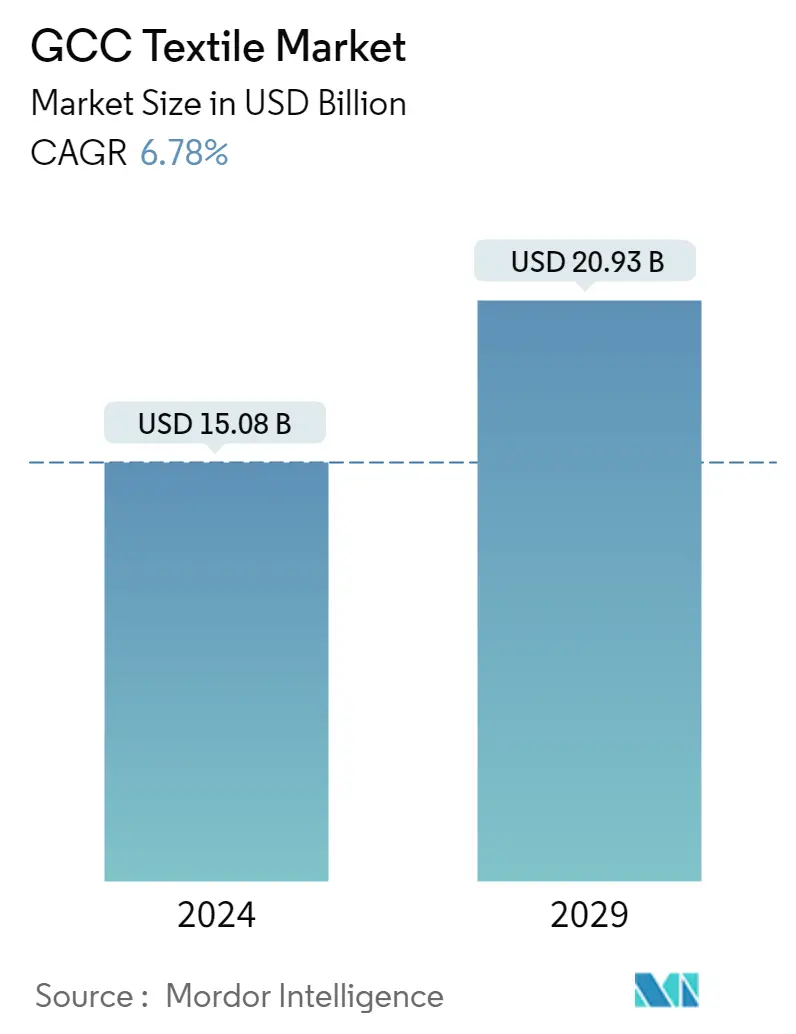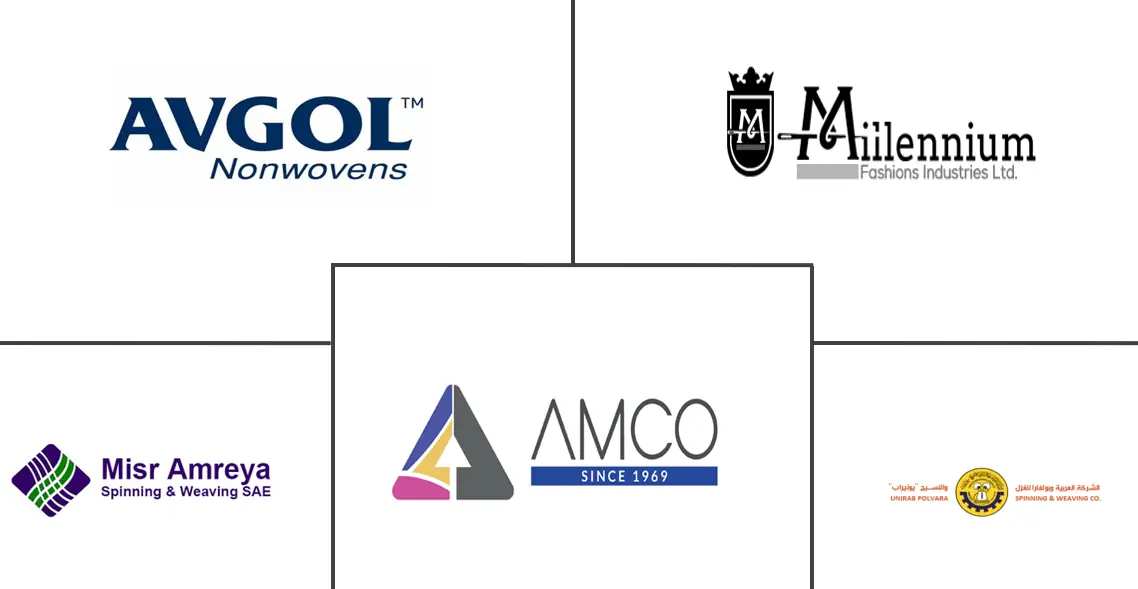| Study Period | 2020 - 2029 |
| Base Year For Estimation | 2023 |
| Forecast Data Period | 2024 - 2029 |
| Market Size (2024) | USD 15.08 Billion |
| Market Size (2029) | USD 20.93 Billion |
| CAGR (2024 - 2029) | 6.78 % |
| Market Concentration | Medium |
Major Players*Disclaimer: Major Players sorted in no particular order |
GCC Textile Market Analysis
The GCC Textile Market size is estimated at USD 15.08 billion in 2024, and is expected to reach USD 20.93 billion by 2029, growing at a CAGR of 6.78% during the forecast period (2024-2029).
- In GCC, the United Arab Emirates (UAE) has a large textile industry, making products such as child safety seats, curtains, luggage, and some high-end fashion for local purchases. However, its best-selling textiles are woven goods like knitwear. This textile industry's contribution to the country's income and employment is second only to the oil and gas industry. Although the UAE sells to over 50 countries, it also has a large customer base domestically.
- The textile business in Dubai benefits retailers who want to design and sell clothing in the apparel industry and investors who wish to construct facilities to produce textile goods like clothing. Dubai has around 16 million foreign visitors annually, and the country's tourism industry is driving growth in the retail industry. Due to this, Dubai now accounts for more than 10% of the country's national gross domestic product, and the city's retail and tourism industries contribute a major chunk to the city's GDP.
- An effort to make the fashion business more sustainable and ecologically friendly has become a major trend in the world of fashion. This has motivated several designers to produce ready-to-wear garments using recycled fabrics. Saudi Arabia's brand Glamming Sisters established an eco-friendly streetwear line to promote the adoption of ethical fashion to promote and increase the adoption of sustainable fashion. The online retailer wants to provide eco-friendly modern clothing that will influence the fashion scene in the Kingdom and give customers trendy designs with a comfortable fit.
- Developments in end-user segments, for instance, residential and commercial (hospitality), and the increasing attentiveness regarding altering inclinations of home-based interior decoration are expected to motivate the home textile industry in Saudi Arabia. The rising rate of urbanization and improved quality of living are responsible for the growing demand for home textiles like bedding, bed sheets, towels, blankets, and covers.
GCC Textile Industry Segmentation
Textiles are materials or fabrics that are made of tiny fibers that can be natural or man-made, and those fibers are then twisted into yarns. Textiles are created by interlocking these yarns in specific patterns, resulting in a length of cloth. Textiles can be classified as natural textiles and synthetic textiles. The GCC Textile Market is segmented by application (Clothing, Industrial/Technical, and Household), by material type (Cotton, Jute, Silk, Synthetics, and Wool), and by process (Woven and Non-Woven). The report offers the market size and forecasts for the GCC textile market in value (USD billion) for all the above segments.
| Clothing |
| Industrial/Technical Applications |
| Household Applications |
| Cotton |
| Jute |
| Silk |
| Synthetics |
| Wool |
| Woven |
| Non-woven |
GCC Textile Market Size Summary
The GCC textile industry is poised for significant growth, driven by the United Arab Emirates' robust market, particularly in Dubai, which serves as a major fashion hub. The UAE's textile sector, second only to oil and gas in terms of economic contribution, is characterized by a diverse range of products, including high-end fashion, woven goods, and technical textiles. The country's strategic initiatives, such as infrastructure development and tax incentives, have fostered a conducive environment for investment and innovation. The rise of e-commerce and digital shopping, accelerated by the pandemic, has further bolstered the region's retail landscape, with a substantial portion of consumers embracing online purchasing. This shift is supported by the region's youthful, tech-savvy population, which values accessibility and convenience in shopping.
In Saudi Arabia, the home textile industry is experiencing growth due to urbanization and changing consumer preferences in interior decoration. The demand for eco-friendly and sustainable fashion is also gaining traction, with brands like Glamming Sisters leading the charge in promoting ethical fashion. The market is fragmented, with numerous players adopting innovative technologies and sustainable practices to attract consumers. Recent investments and partnerships, such as those by Saudi's MODON and Nykaa's collaboration with the Apparel Group, highlight the region's commitment to expanding its textile and apparel sectors. These developments underscore the GCC's position as a burgeoning hub for textiles, combining traditional craftsmanship with modern technology and sustainable practices.
GCC Textile Market Size - Table of Contents
1. MARKET SEGMENTATION
-
1.1 By Application
- 1.1.1 Clothing
- 1.1.2 Industrial/Technical Applications
- 1.1.3 Household Applications
-
1.2 By Material Type
- 1.2.1 Cotton
- 1.2.2 Jute
- 1.2.3 Silk
- 1.2.4 Synthetics
- 1.2.5 Wool
-
1.3 By Process
- 1.3.1 Woven
- 1.3.2 Non-woven
GCC Textile Market Research FAQs
How big is the GCC Textile Market?
The GCC Textile Market size is expected to reach USD 16.10 billion in 2025 and grow at a CAGR of 6.78% to reach USD 22.35 billion by 2030.
What is the current GCC Textile Market size?
In 2025, the GCC Textile Market size is expected to reach USD 16.10 billion.




